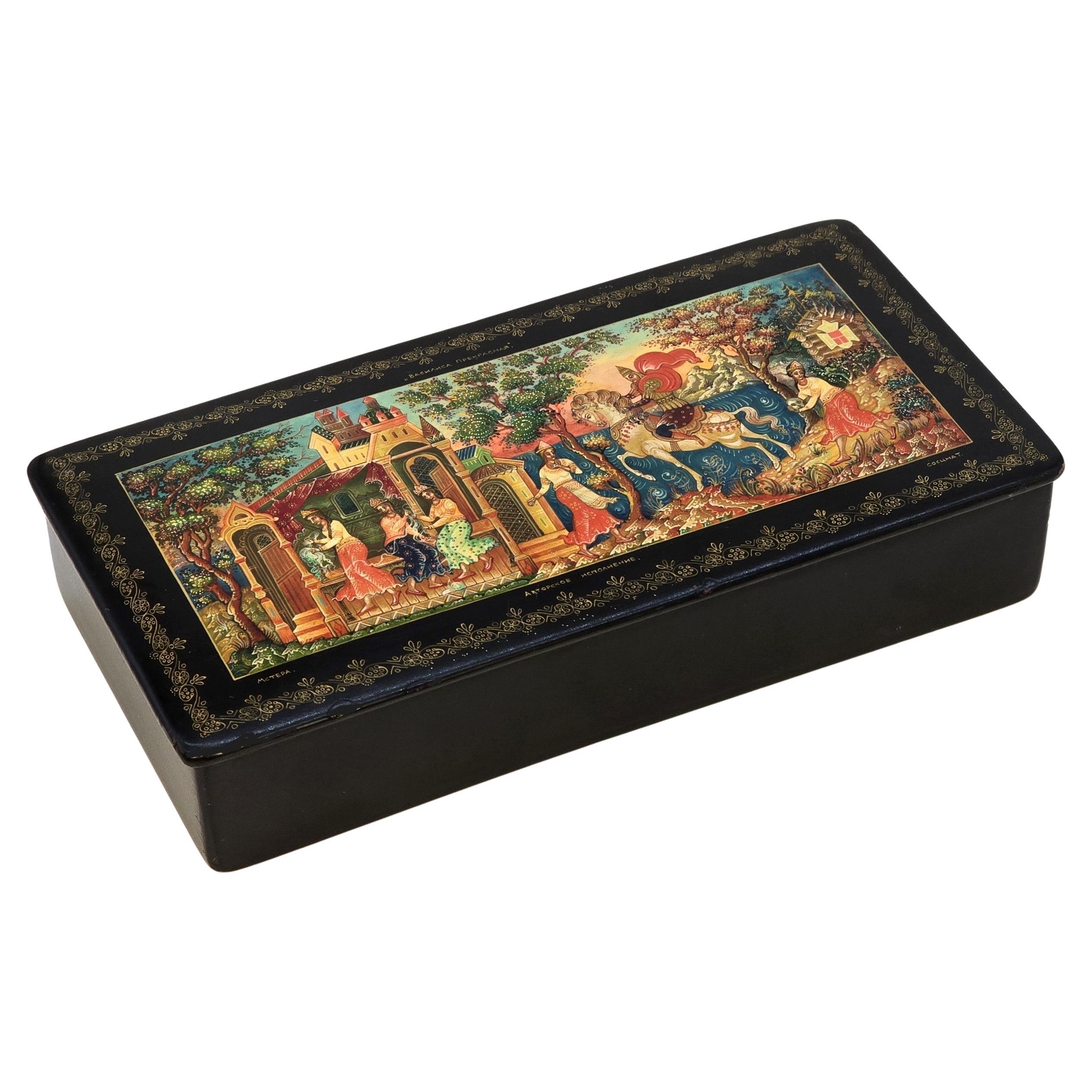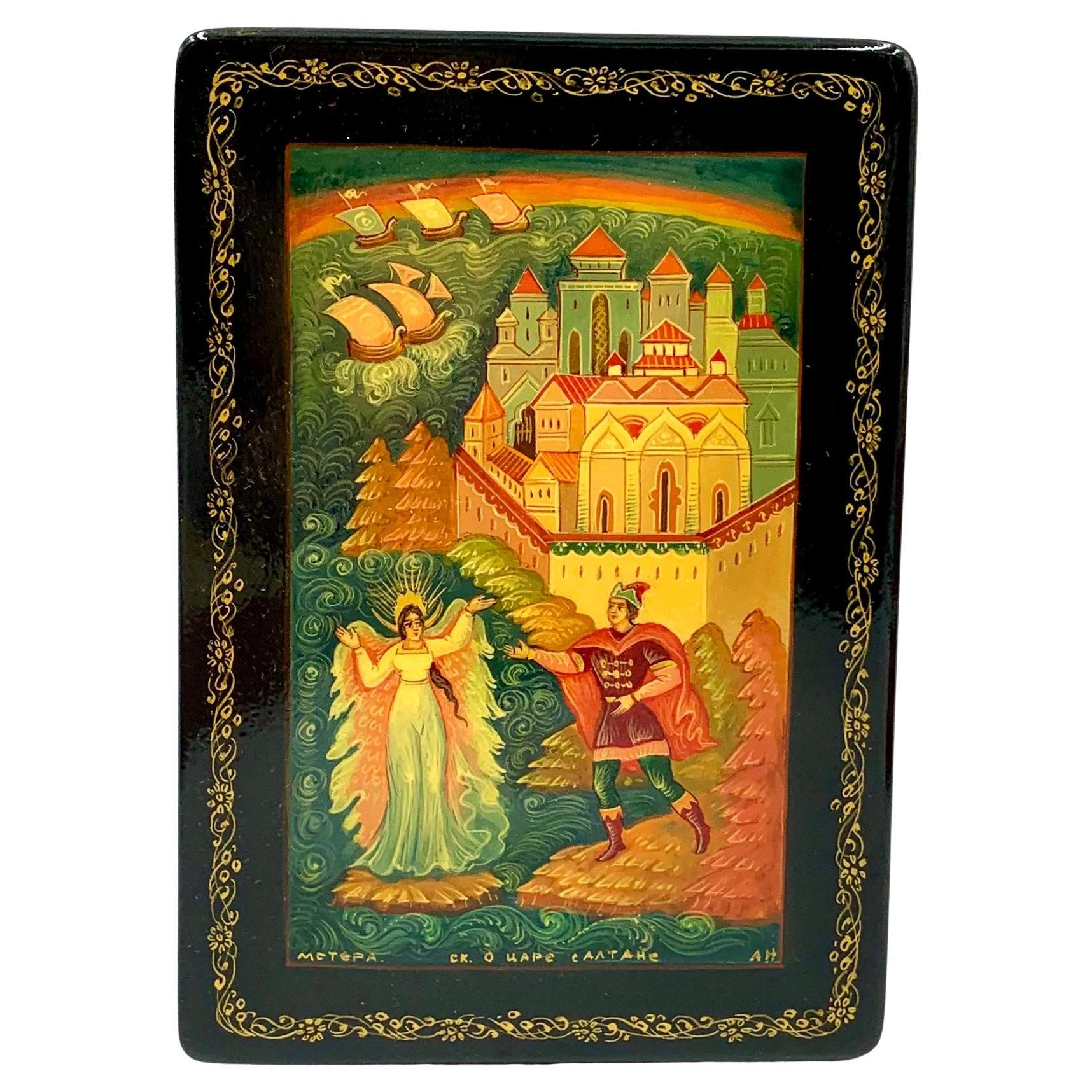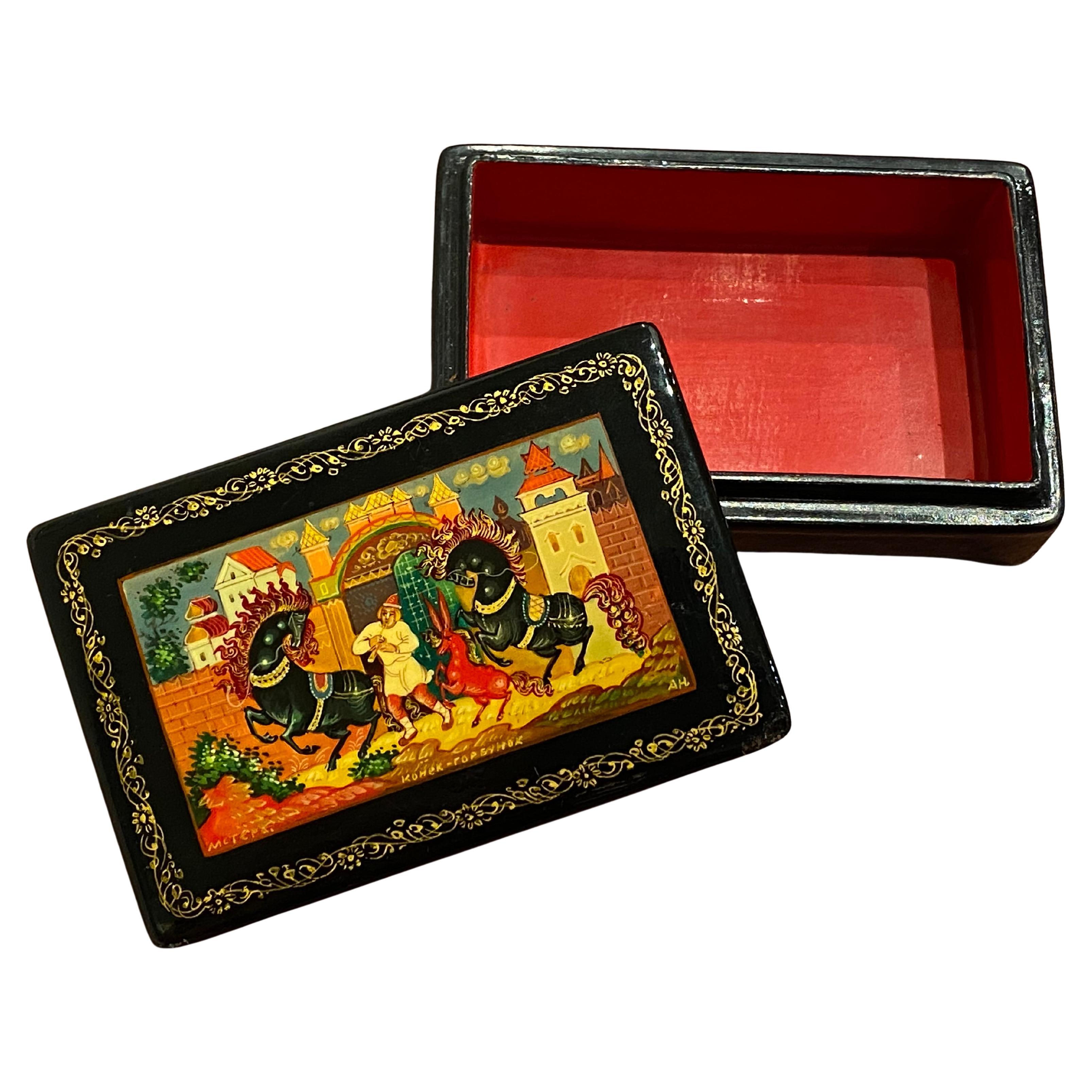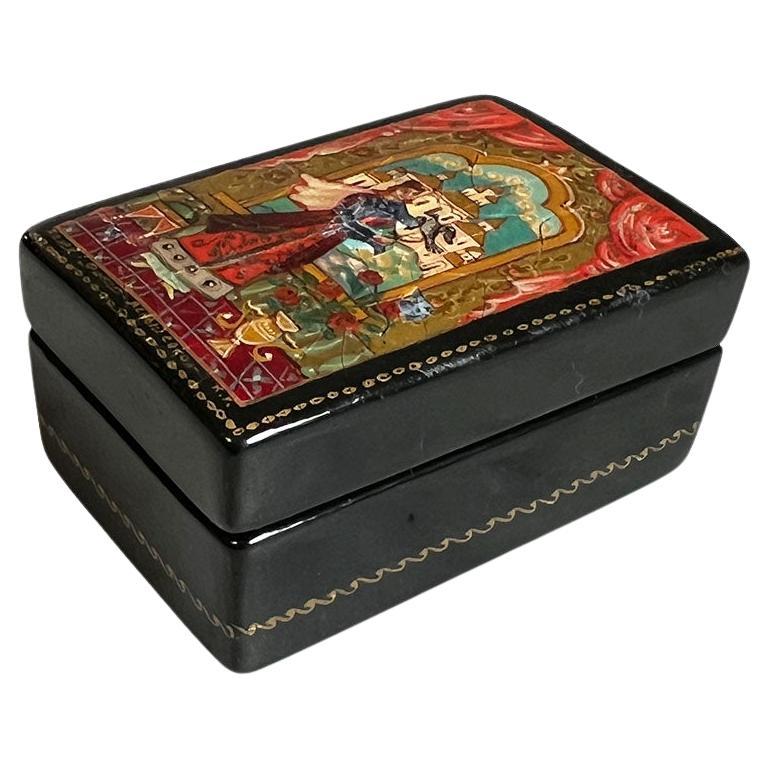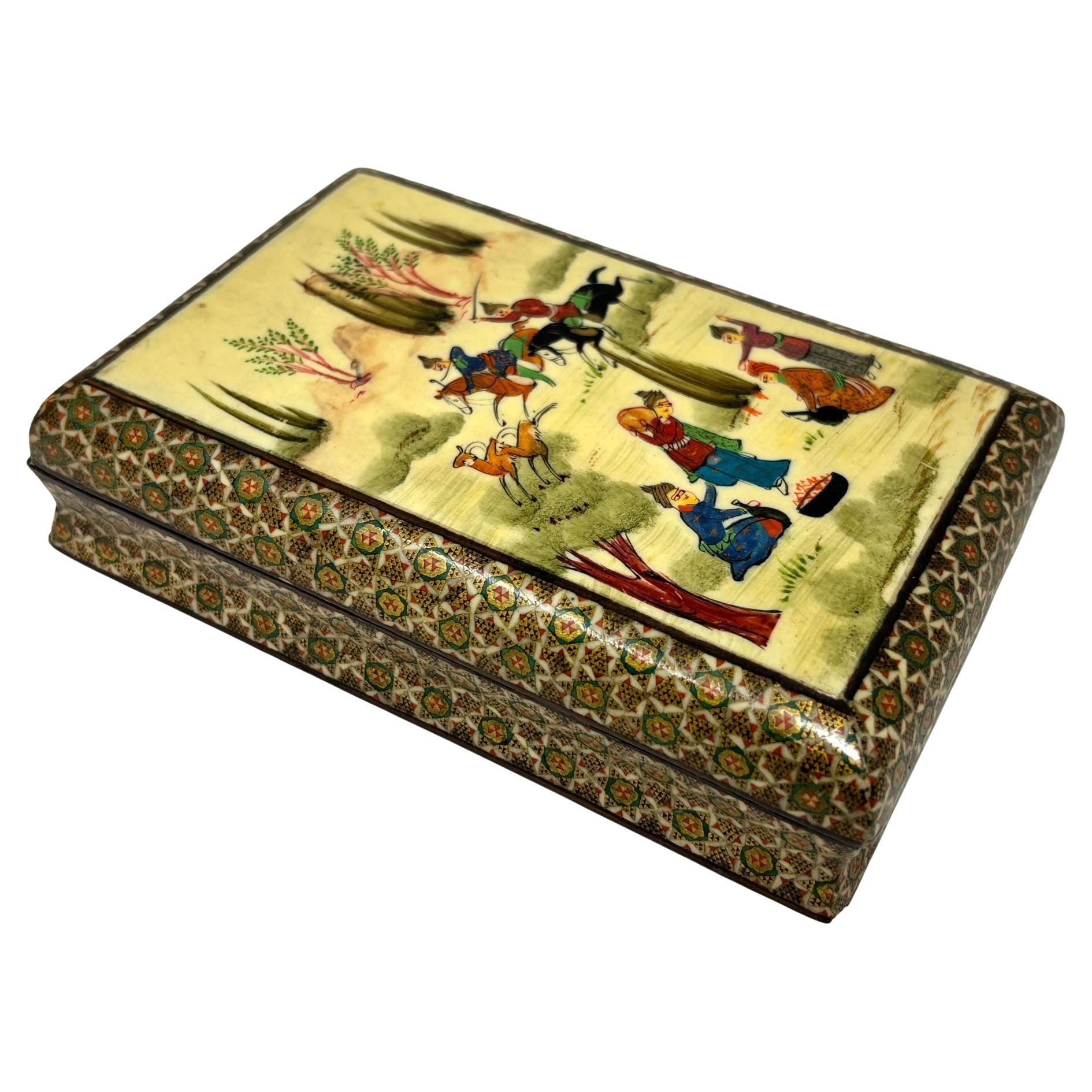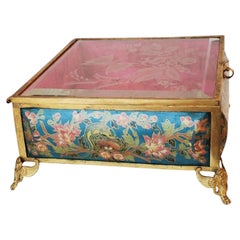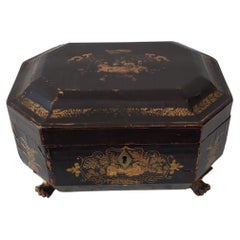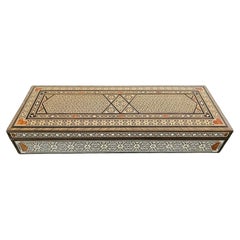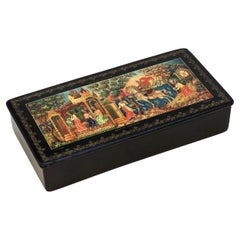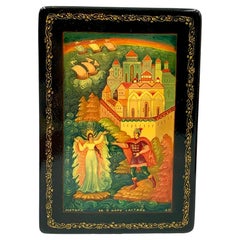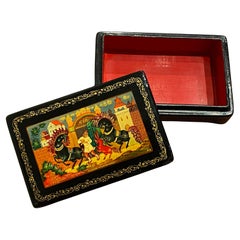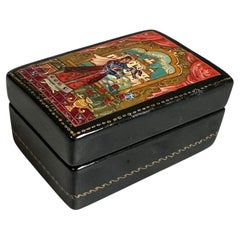Items Similar to Russian Hand Painted Lacquerware Palekh Miniature Table Box
Want more images or videos?
Request additional images or videos from the seller
1 of 21
Russian Hand Painted Lacquerware Palekh Miniature Table Box
$950
£724.65
€825.59
CA$1,335.23
A$1,456.70
CHF 771.32
MX$17,455.47
NOK 9,823.14
SEK 8,982.53
DKK 6,164.58
About the Item
A rare and exceptional finely painted vintage Imperial Russian lacquerware box.
Exquisitely hand-crafted in the Palekhsky District (Палех) of western Russia, the stunning Palekh miniature features black lacquered papier-mâché construction, rectangular footed chest form with a delicate hinged lid, decorated with brilliant colored Tempera hand-painted folksy icon - fairy tale artwork with gilt gold leaf accents, artist signed and tilted along bottom.
A truly stunning, museum quality example, it makes for a wonderfully decorative and artistic table box, and includes a blurb regarding the history of Russian lacquer art, making it a fascinating and generous gift idea.
Dimensions: (approx)
8.25" Wide, 1.5" High, 6.5" Deep
Interior: 7.25" x .5" x 5.5"
Excellent original antique / vintage condition
- Dimensions:Height: 1.5 in (3.81 cm)Width: 8.25 in (20.96 cm)Depth: 6.5 in (16.51 cm)
- Style:Folk Art (In the Style Of)
- Materials and Techniques:
- Place of Origin:
- Period:
- Date of Manufacture:20th century
- Condition:Excellent original vintage condition.
- Seller Location:Forney, TX
- Reference Number:1stDibs: LU5977236968252
About the Seller
4.8
Platinum Seller
Premium sellers with a 4.7+ rating and 24-hour response times
Established in 2013
1stDibs seller since 2021
315 sales on 1stDibs
Typical response time: 1 hour
- ShippingRetrieving quote...Shipping from: Forney, TX
- Return Policy
More From This Seller
View All19th Century Bohemian Moser Attrib Enameled Ormolu Jewel Casket Table Box
Located in Forney, TX
A rare and exceptional Aesthetic Movement period Bohemian enameled jewel casket attributed to luxury glassmaker Moser.
Hand-crafted in the late 19th cent...
Category
Antique 19th Century European Aesthetic Movement Decorative Boxes
Materials
Metal, Ormolu
Antique Chinese Export Black Lacquer Tea Caddy
Located in Forney, TX
A stunning antique Qing Dynasty Chinese export twin canister tea caddy / decorative table box. circa 1860
Hand-crafted in China for the European market when rare and exotic oriental...
Category
Antique 19th Century Chinese Qing Tea Caddies
Materials
Pewter
Large Moorish Arabesque Inlaid Table Box
Located in Forney, TX
A stunning vintage Moorish arabesque inlaid table box, 20th century, high quality rectangular box with hinged lid, featuring contrasting mother of pearl, exotic hardwood, and bone marquetry inlay arranged in geometric patterns, opening to red fabric lined interior.
Dimensions: (approx)
3" High, 16.75" Wide, 6 1/8" Deep; 3.2lbs
As warm and attractive as it is functional, having the ideal large size and proportions for a variety of different uses, including concealing a remote control on your coffee table or sofa table, or as a jewelry casket, trinket case...
Category
20th Century Moorish Decorative Boxes
Materials
Bone, Mother-of-Pearl, Hardwood, Ebony, Rosewood, Tulipwood
17th/18th Century Italian Venetian Marquetry Table Box
Located in Forney, TX
An important early antique Italian Renaissance table box, handcrafted in Northern Italy in the 17th/18th century, cassone chest form, richly inlaid, the top and front panel with fruitwood banding framing...
Category
Antique 18th Century Italian Renaissance Decorative Boxes
Materials
Wood, Fruitwood
Antique Chinese Food Presentation Covered Box
Located in Forney, TX
A remarkable antique food box from the Shanxi province, North China, late Ming (1368-1644) to early Qing (1644-1912) Dynasty.
An extraordinary e...
Category
Antique 17th Century Chinese Ming Decorative Boxes
Materials
Wood, Paint
Antique Vizagapatam India Table Box Ebonized Wood & Bone Carvings
Located in Forney, TX
Vizagapatam box, India, 19th century.
This highly decorative and unusual Anglo-Indian table box features rustic workmanship that adds to the character and charm of this unique Sout...
Category
Antique 19th Century Indian Anglo Raj Decorative Boxes
Materials
Bone, Wood
You May Also Like
A Russian hand painted papier mâché box decorated with intricate scenes C1920
Located in Central England, GB
This top quality Russian black lacquered papier mâché box has an extremely fine hand painted central panel to its lid with a medieval scene set amongst a landscape with a castle and ...
Category
Early 20th Century Other Decorative Boxes
Materials
Lacquer, Paper
Russian Lacquer Hand Painted Tale of Tsar Saltan Box, Mstera, Artist Signed
Located in New York, NY
Soviet era Mstera hand painted, artist signed lacquer box depicting a scene from Pushkin's renown Tale of Tsar Saltan
20th Century
Alexander Sergeevich Pushkin's 1831 masterpiece, "The Tale of Tsar Saltan", a Russian fairy tale...
Category
20th Century Russian Decorative Boxes
Materials
Lacquer
Russian Vintage Lacquer Box. Konek-Gorbunok. Mstera, c1970's, 9cm x 6cm.
Located in MELBOURNE, AU
Fine Vintage Russian Lacquer Box,
depicting scene from Russian Tale about Konek-Gorbunok
(Конек-Горбунок)
beautifully hand-painted against black background &
finely detailed thro...
Category
Vintage 1970s Russian Boxes and Cases
Small Lacquered Painted Box with Russian Tzar Scene on Lid - Signed
Located in Oklahoma City, OK
A small painted and lacquered box with a lid in black. This piece was created in the 1920s in the USSR. It is lacquered in a glossy black, with a hand-painted scene of a tzar on the ...
Category
Early 20th Century Russian Agra Decorative Boxes
Materials
Lacquer, Paint
$240 Sale Price
25% Off
Fine Indo-Persian Micro Mosaic Marquetry Box with Miniature Painting 1940s
Located in Moreno Valley, CA
Fine Micro Mosaic Indo Persian Moorish Inlaid Trinket Jewelry Box with Miniature Polo Scene, circa 1940s
Exceptional handcrafted Indo-Persian jewelry or pen box featuring intricate Sadeli micro mosaic marquetry with inlaid geometric designs and a stunning miniature hand-painted scene on the lid. The artwork depicts 19th-century royal princes in traditional Maharaja attire playing polo, reflecting Mughal and Islamic courtly elegance.
Crafted using the traditional Khatam technique, the box is richly inlaid inside and out with fine slivers of wood, bone, and metal, showcasing exceptional craftsmanship from the Middle East or India, circa 1940s.
* Dimensions: H 1.75 in. x W 6.5 in. x D 4 in.
* Condition: great condition; minor wear consistent with age.
A museum-quality piece comparable to those in the Doris Duke Islamic Art Collection. Perfect for collectors of Islamic art, Moorish marquetry, and antique micro mosaic.
Keywords:
Islamic Marquetry, Sadeli Mosaic, Khatam Box...
Category
Mid-20th Century Indian Anglo Raj Decorative Boxes
Materials
Fruitwood
Hand Painted Rajasthani Lacquer Decorative Box
By Mamluke
Located in Moreno Valley, CA
Hand painted Rajasthani lacquer box in rectangular shape with lid decorated with floral designs.
Great decorative box.
Size is 9" x 5.5" x 2" height.
Overall good condition.
Great Is...
Category
20th Century Indian Moorish Decorative Boxes
Materials
Lacquer
More Ways To Browse
Russian Painted Furniture
Russian Painted Boxes
Russian Lacquer Box
Russian Hand Painted Lacquer Box
Antique Russian Furniture Tables
Russian Lacquer Box Fairy Tale
Rosewood Box Inlay
Russia Silver Box
Vintage Abalone
Vintage Sterling Pill Box
Antique Burr Walnut Box Boxes
Antique Chinese Enamel Box
Antique Hand Carved Wooden Boxes
Decorative Eggs Painted
Gold Trinket Box
Green Glass Box
Green Glass Boxes
Italian Trinket Box
